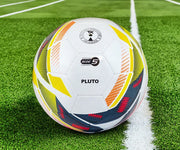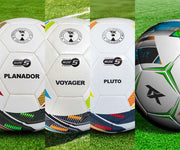The 4-3-3 soccer formation is more than just a strategy—it’s a game-changer. This formation strikes the perfect balance between structure and freedom, providing teams with the tools to excel across all areas of play.
Loved by champions and tacticians worldwide, the 4-3-3 soccer formation offers versatility and control that few other formations can match. Discover what makes this setup a favorite and how it can elevate any team’s game.
What is the 4-3-3 Soccer Formation?
The 4-3-3 soccer formation has four defenders, three midfielders, and three attackers. The defenders include two center-backs, who stay in the middle to protect the goal, and two full-backs, who play on the sides and help both in defense and attack. This setup provides good balance and width on the field.
In midfield, one player stays back to defend while the other two move forward to create scoring chances. The attackers include two wingers on the sides and a central striker, making the team strong in attack. This formation is flexible, allowing teams to switch quickly between defending and attacking.
Origins of the 4-3-3 Soccer Formation
The 4-3-3 soccer formation became famous in the 1970s thanks to Rinus Michels, who introduced "Total Football" with his Ajax and Netherlands teams. This style focused on players switching roles, pressing the opponents, and smart positioning on the field, all key features of the 4-3-3.
Moreover, Johan Cruyff helped make this formation even more popular during his time as a player and coach. Later, Pep Guardiola's Barcelona showed how effective it could be, making it a favorite in modern soccer. Today, the 4-3-3 is loved for its balance and flexibility.
Key Roles in a 4-3-3 Formation
Defenders:
- Center-Backs: Protect the goal, block passes, and start attacks from the back.
- Full-Backs: Play on the sides, support attacks by overlapping wingers, and stop counter-attacks.
Midfielders:
-
Defensive Midfielder (CDM): Stays close to the defense, stops opponents, and controls the game’s flow.
-
Central Midfielders (LCM & RCM):
-
Help both in defense and attack.
-
Create chances with passes and support forward runs.
-
Defend by blocking passes and regaining possession.
-
Central Attacking Midfielder (CAM): Links midfield with attackers, sets up goals, and makes runs into the opponent’s penalty area.
Forwards:
- Wingers: Play wide, beat defenders, cross the ball, or cut inside to shoot.
- Striker: Leads the attack, scores goals, and connects with teammates to keep the play going.
Strategies in Possession
The 4-3-3 formation works well for keeping control and creating space. Teams play wide to stretch the opponent’s defense, giving midfielders room to work in the center. Players often form triangles, making it easier to pass and keep the ball moving smoothly.
Wingers sometimes move toward the center, creating space for full-backs to join the attack on the outside. Furthermore, the attacking midfielder helps the striker by adding extra support in the opponent's penalty area. This strategy keeps pressure on the other team and increases chances to score.
Strategies Out of Possession
Defensively, the 4-3-3 excels in high pressing. The forwards work hard to put pressure on the opponent’s defenders, forcing them to make mistakes or lose the ball.
Midfielders drop back to help protect the defenders and win the ball quickly. The team stays compact in the center to stop opponents from attacking through the middle, while full-backs and wingers work together to block attacks from the sides. Additionally, this discipline makes the 4-3-3 very effective defensively.
Why Teams Love the 4-3-3 Formation
The 4-3-3 has many advantages:
- Balanced Play: It’s strong in both defense and attack.
- Midfield Control: Extra players in the middle help keep possession and control the game.
- Versatility: Teams can press high or defend deep, depending on the situation.
Challenges and Weaknesses of the 4-3-3 Formation
The 4-3-3 also has some challenges:
- Wide Weaknesses: Opponents can attack the spaces between the wingers and full-backs.
- Counter-Attack Risk: Pushing too many players forward can leave the defense exposed.
- Striker Support: The striker may struggle to score if not well-supported by teammates.
Case Studies of Successful 4-3-3 Soccer Formation Teams
Rinus Michels' Ajax
Rinus Michels changed football in the 1970s with his "Total Football" philosophy, which was showcased by his Ajax team. Using the 4-3-3 formation, players switched positions and didn’t stick to fixed roles. Johan Cruyff, the team’s star, often dropped back, moved around, and controlled the game, showing the true spirit of Total Football.
Furthermore, Ajax’s players were very versatile` and adapted to different roles during matches. Their high pressing, accurate passing, and smart positioning made them unbeatable in domestic and European competitions.
Zinedine Zidane’s Real Madrid
Zinedine Zidane’s Real Madrid used the 4-3-3 to make the most of their star players. Cristiano Ronaldo and Gareth Bale played as inverted wingers, cutting inside to shoot or link up with Karim Benzema, who was great at holding the ball and creating space.
The midfield trio of Luka Modric, Toni Kroos, and Casemiro balanced creativity and defense perfectly. Modric’s vision created chances, Kroos controlled the game with his passing, and Casemiro provided defensive strength. Moreover, Full-backs Marcelo and Dani Carvajal added attacking width, making the team strong and well-rounded in Europe.
Pep Guardiola’s Barcelona
Pep Guardiola’s Barcelona is considered the best example of the 4-3-3. Lionel Messi played as a false nine, dropping back to connect midfield and attack, confusing defenders. Xavi Hernandez controlled the game with his amazing passing, while Andres Iniesta added creativity and clever runs to break defenses.
Full-backs Dani Alves and Eric Abidal provided width by moving up the field, helping the team’s precise passing and movement shine. Their style of high pressing, constant movement, and keeping possession defined their era of dominance.
Jürgen Klopp’s Liverpool
Jürgen Klopp’s Liverpool used a fast and energetic version of the 4-3-3, focusing on pressing and quick attacks. Mohamed Salah and Sadio Mane cut inside to attack central spaces, while Roberto Firmino dropped back to connect with the midfield.
Full-backs Andrew Robertson and Trent Alexander-Arnold provided width and created chances with accurate crosses. In midfield, Fabinho protected the defense, while Jordan Henderson and Georginio Wijnaldum pressed opponents and helped with fast counters. This approach made Liverpool one of the best teams in both domestic and European competitions.
Tips for Potential Coaches and Players to Ace the 4-3-3 Formation
- Teamwork: Focus on building strong connections between the midfielders and attackers. They should understand each other’s movements and work as a unit.
- Practice: Train regularly on high pressing and quick transitions to improve speed and efficiency during games.
- Discipline: Teach players to stay organized in defense, especially when the team is switching from attack to defense.
Conclusion
The 4-3-3 soccer formation is a game-changer, blending creativity and structure. Its balance makes it a favorite for teams at all levels. Try it out and experience how it transforms your game.
FAQs
What is 4-3-3 formation good for?
It’s great for balance, attacking creativity, and controlling the midfield.
Who plays a 4-3-3 soccer formation?
Top teams like Barcelona, Liverpool, and Real Madrid often use it.
Why is 4-3-3 so popular?
It’s versatile, allowing teams to attack and defend effectively.
What formation does Pep Guardiola use?
Guardiola adapts, but he often uses variations of the 4-3-3 or 3-2-4-1.
What is José Mourinho's tactic?
Mourinho focuses on defense first, using tactics like counter-attacks and compact setups.
Should a left winger be right-footed?
There is no definite rule for it, but it gives a team an edge if LW is right-footed. For example, Cristiano Ronaldo excelled at cutting inside and shooting with his stronger right foot when playing in this position. Similarly, modern stars like Kylian Mbappé and Vinícius Jr. often use this technique effectively.







